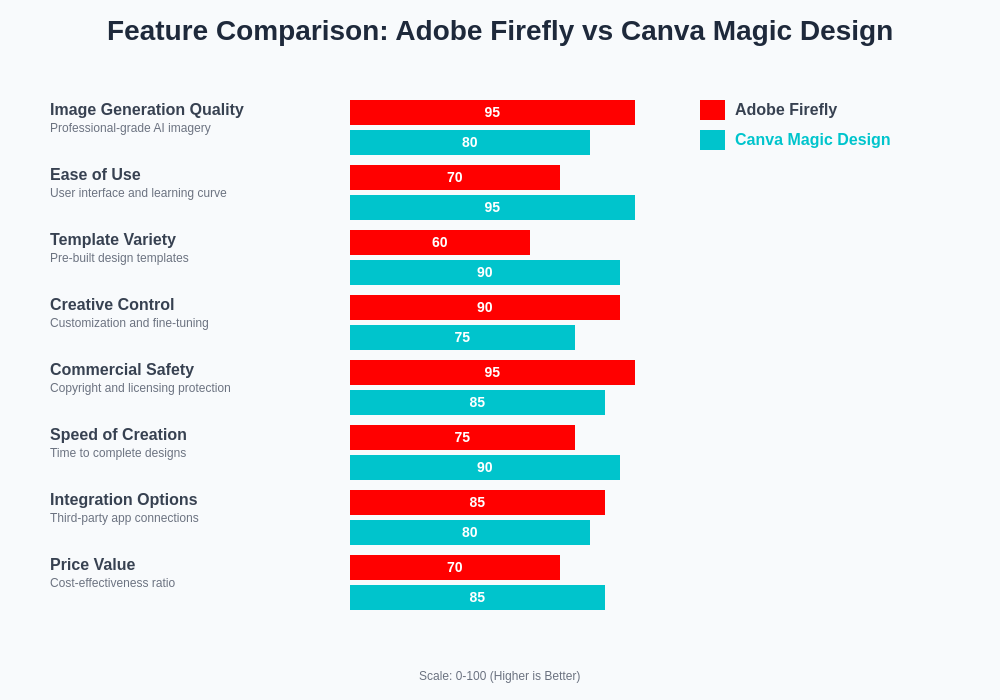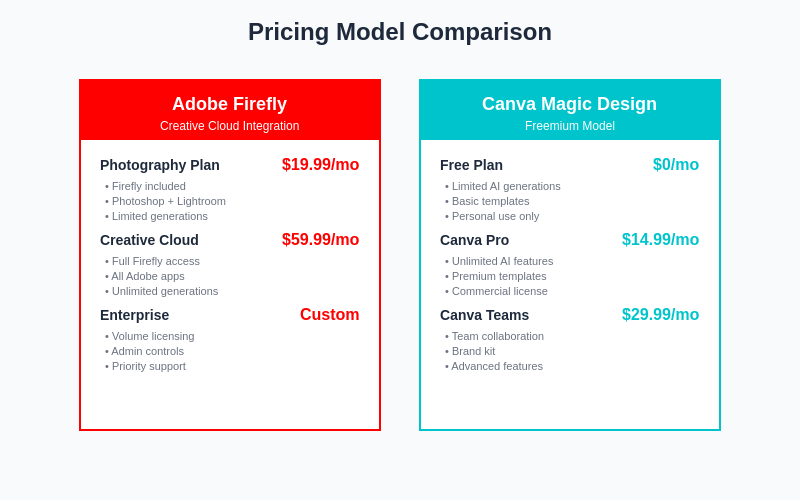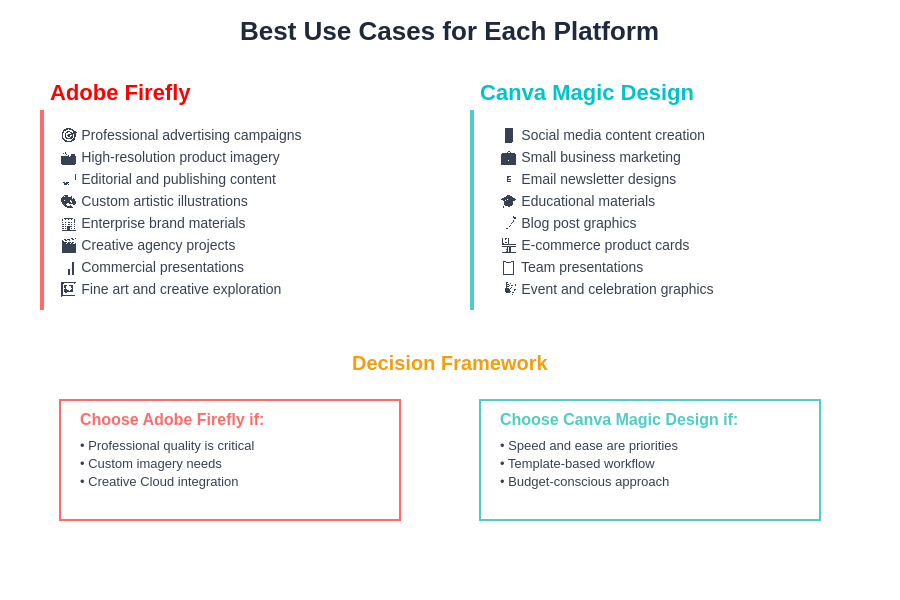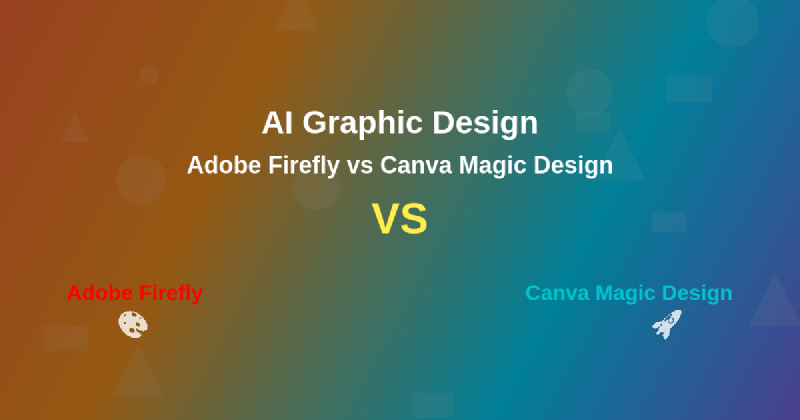The creative landscape has been fundamentally transformed by the advent of artificial intelligence in graphic design, with two major platforms leading this revolutionary charge: Adobe Firefly and Canva Magic Design. These powerful AI-driven tools have democratized the design process, enabling both professional designers and creative novices to produce stunning visual content with unprecedented speed and sophistication. As businesses and individuals increasingly recognize the importance of compelling visual communication in our digital-first world, understanding the capabilities, limitations, and optimal applications of these competing platforms becomes essential for making informed decisions about creative workflows and resource allocation.
Explore the latest AI design trends and innovations to discover cutting-edge techniques and emerging technologies that are shaping the future of visual creativity. The integration of artificial intelligence into design workflows represents more than just technological advancement; it signifies a fundamental shift in how we conceptualize, create, and iterate on visual content across industries and applications.
The Evolution of AI-Powered Design Tools
The emergence of AI graphic design tools marks a pivotal moment in creative technology, where machine learning algorithms can now understand artistic intent, generate original compositions, and adapt visual elements to specific brand requirements and aesthetic preferences. Adobe Firefly, built upon decades of creative software expertise and trained on Adobe Stock’s vast repository of licensed content, represents a sophisticated approach to AI-assisted design that prioritizes commercial safety and professional-grade output quality. Meanwhile, Canva Magic Design leverages the platform’s extensive template library and user behavior data to create an intuitive, accessible AI experience that caters to the broader market of content creators and small businesses.
Both platforms have recognized that the future of design lies not in replacing human creativity but in augmenting it with intelligent automation that handles routine tasks, suggests creative alternatives, and accelerates the iterative design process. This philosophical approach has shaped their respective development strategies, resulting in tools that complement rather than compete with human artistic judgment while dramatically reducing the time and technical expertise required to produce professional-quality visual content.
Adobe Firefly: Professional-Grade AI Creativity
Adobe Firefly emerges as a comprehensive AI creative suite specifically engineered for professional designers and enterprises requiring sophisticated visual content generation capabilities. Built upon Adobe’s extensive experience in creative software development and integrated seamlessly with the Creative Cloud ecosystem, Firefly offers advanced text-to-image generation, style transfer capabilities, and intelligent content-aware editing tools that maintain the high-quality standards expected by creative professionals and commercial applications.
The platform’s strength lies in its sophisticated understanding of design principles, color theory, and composition rules, enabling it to generate images that not only meet technical specifications but also demonstrate aesthetic coherence and commercial viability. Firefly’s training on Adobe Stock’s curated content library ensures that generated images maintain professional quality while respecting intellectual property considerations, making it particularly valuable for commercial projects where copyright compliance is paramount.
Experience advanced AI capabilities with Claude for comprehensive design analysis and creative strategy development that complements your visual content creation workflow. The integration of multiple AI tools creates a powerful creative ecosystem where strategic thinking and visual execution work in harmony to achieve superior design outcomes.
Canva Magic Design: Accessible AI for Everyone
Canva Magic Design represents a different philosophy in AI-powered design, prioritizing accessibility, ease of use, and rapid content creation over the complex feature sets traditionally associated with professional design software. The platform’s AI capabilities are deeply integrated into Canva’s existing template-based design approach, allowing users to generate complete design compositions through simple text prompts while maintaining the platform’s characteristic user-friendly interface and extensive customization options.
The magic of Canva’s approach lies in its ability to understand user intent and translate basic descriptions into polished, brand-consistent designs that require minimal additional editing. The platform excels in creating social media graphics, presentations, marketing materials, and other standard business communications, leveraging its vast template library and user behavior analytics to suggest design elements and layouts that have proven effective across different industries and use cases.
Magic Design’s strength extends beyond individual asset creation to encompass entire design systems and brand-consistent content series, making it particularly valuable for small businesses, content creators, and marketing teams who need to maintain visual consistency across multiple touchpoints without investing in extensive design expertise or resources.
Feature Comparison and Technical Capabilities
The technical capabilities of Adobe Firefly and Canva Magic Design reflect their different target audiences and use case priorities, with each platform offering distinct advantages in specific creative scenarios. Firefly excels in generating high-resolution, photorealistic images with sophisticated lighting, texture, and composition control, making it ideal for advertising campaigns, product visualizations, and editorial content that requires professional-grade imagery.
Canva Magic Design focuses on layout generation, template customization, and brand-consistent design creation, offering features like automatic text placement, color scheme generation, and multi-format content adaptation that streamline the creation of marketing materials, social media content, and business communications. The platform’s AI understands common design patterns and automatically applies typography hierarchies, spacing principles, and visual balance considerations that ensure professional-looking results.
Both platforms offer text-to-image generation capabilities, but with different strengths and limitations. Firefly provides more granular control over artistic style, lighting conditions, and compositional elements, while Canva Magic Design emphasizes speed, template integration, and brand consistency. The choice between platforms often depends on whether projects require custom imagery creation or efficient adaptation of existing design frameworks.

The comprehensive feature analysis reveals distinct performance profiles for each platform, with Adobe Firefly excelling in areas requiring sophisticated creative control and commercial-grade output quality, while Canva Magic Design demonstrates superior performance in accessibility, speed, and template-based workflow efficiency.
User Experience and Interface Design
The user experience philosophy underlying each platform significantly impacts their practical application in different creative workflows and organizational contexts. Adobe Firefly maintains the sophisticated interface paradigms familiar to Creative Cloud users, offering extensive parameter controls, layer management capabilities, and integration touchpoints with other Adobe applications that professional designers expect and rely upon for complex projects.
Canva Magic Design prioritizes intuitive interaction patterns and streamlined workflows that minimize the learning curve for users without extensive design experience. The platform’s conversational AI interface allows users to describe their design requirements in natural language, while the underlying system translates these descriptions into specific design parameters and template selections that produce coherent visual results.
The distinction in user experience design reflects broader philosophical differences about who should have access to powerful design tools and what level of technical complexity is appropriate for different user segments. Firefly assumes users want granular control and are willing to invest time in learning sophisticated features, while Canva Magic Design assumes users prioritize speed and simplicity over comprehensive customization options.
Discover comprehensive AI research capabilities with Perplexity to enhance your understanding of design trends, user behavior patterns, and market dynamics that inform strategic creative decisions. The combination of design tools and research capabilities enables more informed creative choices that align with audience preferences and industry standards.
Pricing Models and Value Propositions
The economic considerations surrounding Adobe Firefly and Canva Magic Design reveal different approaches to monetizing AI-powered creative tools and serving distinct market segments with varying budget constraints and usage patterns. Adobe Firefly operates within the Creative Cloud subscription ecosystem, offering AI capabilities as part of comprehensive creative software packages that provide extensive value for professional designers and creative teams who utilize multiple Adobe applications in their workflows.
Canva Magic Design employs a freemium model with tiered subscription options that make AI-powered design accessible to individual creators, small businesses, and teams with limited budgets while offering enhanced capabilities and commercial usage rights through paid plans. This pricing approach reflects Canva’s commitment to democratizing design tools and reducing barriers to professional-quality visual content creation.
The value proposition for each platform extends beyond simple feature comparison to encompass ecosystem integration, learning curve considerations, and long-term creative workflow optimization. Organizations must evaluate not only the direct costs of AI design tools but also the indirect benefits of improved creative efficiency, brand consistency, and content production scalability that these platforms enable.

The pricing structures reflect fundamentally different approaches to market positioning and user acquisition, with Adobe Firefly positioned as a premium professional tool within a comprehensive creative ecosystem, while Canva Magic Design offers accessible entry points with scalable upgrade paths that accommodate diverse user needs and budget constraints.
Integration Capabilities and Workflow Enhancement
The ability of AI design tools to integrate seamlessly with existing creative workflows and technology stacks significantly impacts their practical value in professional environments and organizational contexts. Adobe Firefly’s deep integration with Creative Cloud applications enables sophisticated workflows where AI-generated content can be seamlessly incorporated into complex design projects, video productions, and marketing campaigns that require coordination across multiple creative disciplines.
Canva Magic Design offers extensive integration capabilities with popular business and marketing platforms, including social media management tools, email marketing systems, and content management platforms that enable automated content distribution and brand consistency maintenance across multiple channels. These integrations reflect Canva’s understanding that design is often part of broader marketing and communication strategies rather than an isolated creative activity.
Both platforms recognize that modern creative work rarely exists in isolation, and successful AI design tools must function as components within larger creative and business ecosystems. The strength of these integrations often determines the practical adoption success of AI design tools within organizations and individual creative practices.
Content Quality and Commercial Viability
The commercial viability of AI-generated design content represents a critical consideration for businesses and creative professionals who must ensure that their visual materials meet legal, ethical, and quality standards required for commercial applications. Adobe Firefly’s training on licensed Adobe Stock content and commitment to commercial-safe AI generation provides strong intellectual property protections and quality assurance that professional users require for client work and commercial campaigns.
Canva Magic Design employs similar approaches to content safety and commercial viability, utilizing licensed imagery and design elements in its AI training while providing clear usage rights and commercial licensing options that enable business applications. The platform’s focus on template-based design creation also reduces certain intellectual property risks by building upon established design frameworks rather than generating entirely novel compositions.
Quality consistency represents another crucial factor in commercial applications, where AI-generated content must maintain professional standards across different projects, formats, and use cases. Both platforms have invested significantly in quality control mechanisms and user feedback systems that continuously improve output consistency and reliability.
Specialized Use Cases and Industry Applications
Different creative industries and use cases reveal the distinct strengths and optimal applications of Adobe Firefly versus Canva Magic Design, with each platform excelling in specific scenarios while facing limitations in others. Firefly’s sophisticated image generation capabilities make it particularly valuable for advertising agencies, product marketers, and editorial publications that require custom imagery with specific artistic qualities, lighting conditions, and compositional requirements.
Canva Magic Design excels in applications requiring rapid content creation, brand consistency, and template-based design adaptation, making it ideal for social media management, small business marketing, educational content creation, and organizational communications where efficiency and visual coherence are prioritized over artistic uniqueness.
The publishing industry has found particular value in Firefly’s ability to generate book covers, editorial illustrations, and marketing materials that require sophisticated artistic execution, while educational institutions and nonprofit organizations often benefit more from Canva Magic Design’s accessible interface and cost-effective content creation capabilities.

Strategic platform selection requires careful consideration of specific organizational needs, creative requirements, and resource constraints, with each platform offering optimal solutions for distinct use cases and creative scenarios that align with their core strengths and design philosophies.
Performance, Speed, and Scalability Considerations
The technical performance characteristics of AI design tools significantly impact their practical utility in different organizational contexts and creative workflows where time constraints, resource limitations, and scalability requirements vary considerably. Adobe Firefly’s sophisticated AI models require substantial computational resources but deliver high-quality results that often require minimal additional editing or refinement, making the platform efficient for projects where output quality is paramount.
Canva Magic Design prioritizes rapid generation and iteration capabilities, enabling users to quickly explore multiple design concepts and variations without significant time investment per iteration. This approach proves particularly valuable in social media marketing, content series creation, and other applications where volume and consistency matter more than individual artistic excellence.
Scalability considerations extend beyond individual user performance to encompass team collaboration, brand management, and content governance capabilities that enable organizations to maintain quality and consistency as their creative operations grow and evolve.
Future Development Trajectories and Innovation Paths
The ongoing evolution of Adobe Firefly and Canva Magic Design reflects broader trends in AI development, creative technology, and user experience design that will shape the future landscape of AI-powered creative tools. Adobe’s continued investment in sophisticated AI research and integration with professional creative workflows suggests a trajectory toward increasingly powerful tools that maintain professional-grade quality while expanding accessibility through improved user interfaces and streamlined workflows.
Canva’s development focus on democratizing design and expanding into new creative domains indicates a future where AI-powered design tools become increasingly accessible to broader audiences while maintaining the quality and functionality required for professional applications. The platform’s emphasis on collaboration, brand management, and workflow integration suggests continued evolution toward comprehensive creative management solutions.
Both platforms are likely to continue expanding their AI capabilities while addressing current limitations in areas such as video generation, interactive design, and advanced typography, creating more comprehensive creative ecosystems that serve evolving user needs and technological possibilities.
Strategic Decision Framework for Platform Selection
Choosing between Adobe Firefly and Canva Magic Design requires careful consideration of organizational needs, user capabilities, budget constraints, and long-term creative strategy objectives that extend beyond simple feature comparison to encompass workflow integration, scalability planning, and strategic alignment with broader business goals. Professional design teams and agencies may find greater value in Firefly’s sophisticated capabilities and Creative Cloud integration, while small businesses and content creators might benefit more from Canva Magic Design’s accessibility and cost-effectiveness.
The decision framework should evaluate factors including current design tool usage, team skill levels, content volume requirements, brand complexity, and integration needs with existing marketing and communication systems. Organizations should also consider the learning curve associated with each platform and the ongoing training and support requirements necessary for successful adoption and utilization.
Long-term strategic considerations include platform roadmap alignment, vendor relationship management, and the potential for creative workflow evolution as AI capabilities continue advancing and organizational needs change over time.
Conclusion and Future Outlook
The comparison between Adobe Firefly and Canva Magic Design reveals two complementary approaches to AI-powered design that serve different segments of the creative market while advancing the broader goal of making sophisticated design capabilities more accessible and efficient. Rather than viewing these platforms as direct competitors, creative professionals and organizations benefit most from understanding their distinct strengths and optimal applications within comprehensive creative strategies.
The future of AI graphic design lies not in the dominance of any single platform but in the continued evolution of diverse tools that serve different creative needs while maintaining high standards of quality, commercial viability, and user experience. As these platforms continue developing and expanding their capabilities, users will benefit from increased choice, improved functionality, and more sophisticated integration options that enhance rather than replace human creativity.
The ongoing revolution in AI-powered design tools represents just the beginning of a broader transformation in how visual content is created, distributed, and consumed across industries and applications, promising continued innovation and democratization of professional-quality design capabilities.
Disclaimer
This article is for informational purposes only and does not constitute professional advice. The comparison is based on publicly available information and general observations about AI design tools. Features, pricing, and capabilities may change over time. Readers should conduct their own research and testing to determine which platform best meets their specific needs and requirements. The effectiveness of AI design tools may vary depending on use cases, user experience, and individual creative objectives.
